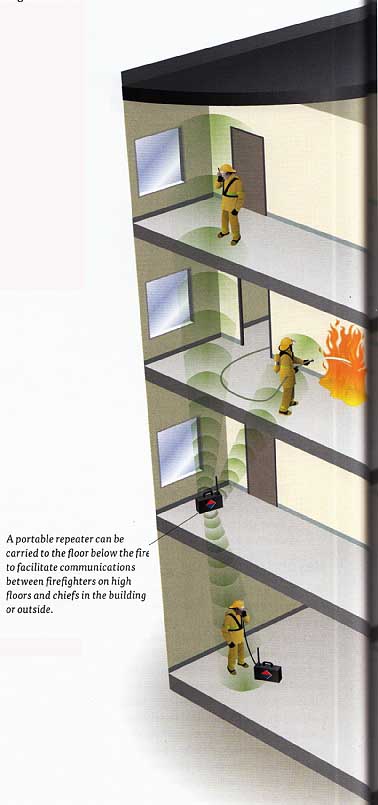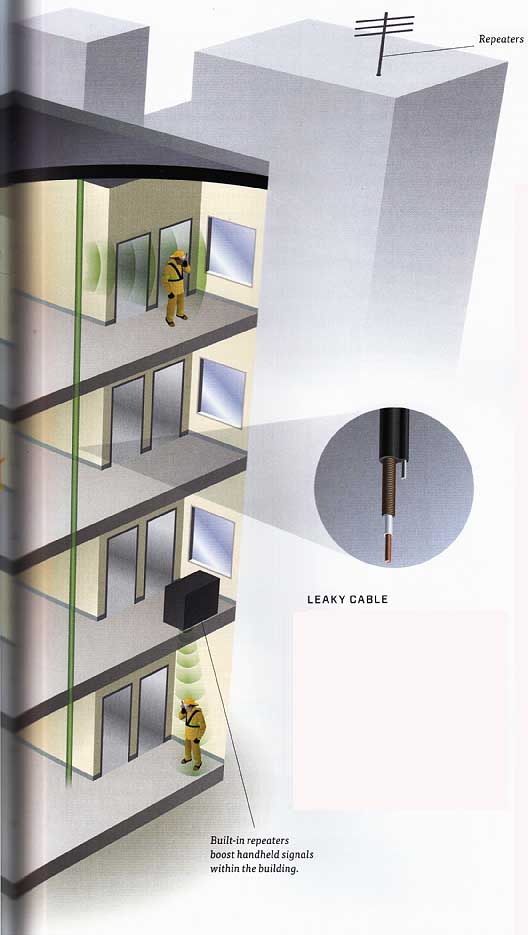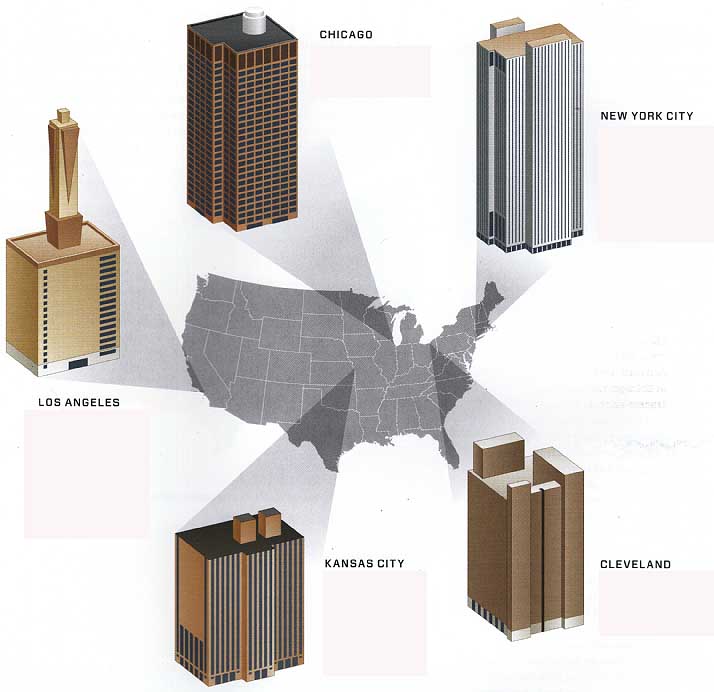While the invention of elevators, central heating, and plumbing in the late 19th century made life in the sky possible, the invention of the telephone certainly made it easier. Getting messages to and from people atop the new skyscrapers would have been cumbersome when they reached a dozen or so floors, and next to impossible as they soared to 50 and 60 stories in the early years of the twentieth century.
Skyscrapers did not yet exist when Alexander Graham Bell, a professor of elocution by trade, invented the telephone in 1876. By converting sound waves into electrical signals, Bell found a way to transmit voices electronically from one place to another—realizing his goal of creating a “talking telegraph.”
Within a year of his invention’s debut, he had formed the Bell Telephone Company. Five years later most major cities had telephone exchanges operating under license from his company. By 1904, thousands of independent telephone businesses had sprung up across the country—though most couldn’t talk to one another, and it was only a matter of time until they would be integrated.
----
Data wave---In 1965, Intel cofounder Gordon Moore predicted that the number of transistors on a chip would double about every two years. Processing power has steadily risen since then because of increased transistor counts and the need for faster communication to share massive amounts of data.
----
While the scientific principle of using electricity signals shaped like sound waves to transmit the voice was universal, the actual equipment used to talk on the phone varied from place to place. In rural areas most telephones were powered by a “magneto” or “crank” and incorporated a battery. Turning the crank sent a signal through the wire to alert a central operator that a call needed to be placed. In contrast, systems in larger cities were powered centrally by what was known as a “talk battery” at a central telephone exchange; local users needed only to pick up the phone to request a connection.
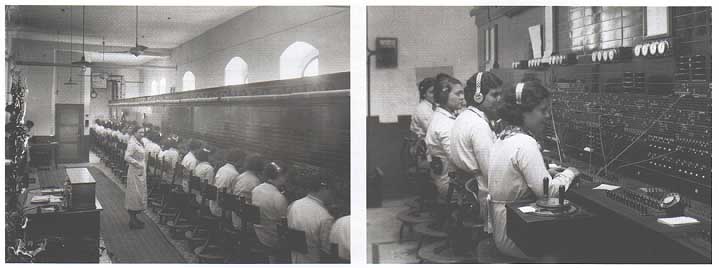
(left) Switchboards were use to make and route calls to their destinations. (right)
Most switchboards were staffed by women, because they were thought to be more
polite.
Typically operators at a switchboard took the name of the party being called and plugged the call into a line to carry it either to another part of the office or to another office, where a second operator would contact the party. Originally these operators were young boys, many of them in their teens. But in the 1890s, these boys were gradually replaced by “telephone girls” or “hello girls”—women well versed in manners and enunciation and better able to follow a standard operator script.
For the first two decades of the twentieth century, most calls were local in nature. The first transatlantic connection was made in 1915, and for some time thereafter long-distance users had to make appointments to use special soundproof telephone booths for their long-distance calls. These calls typically took longer to place than local ones—particularly during the Second World War, when lines were reserved for military purposes and callers could wait up to two hours for a connection.
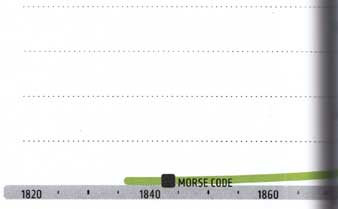
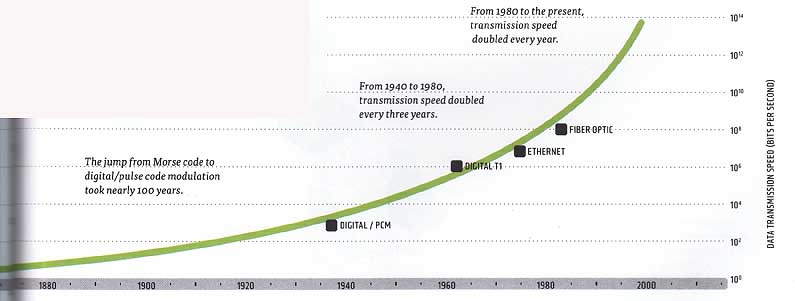
The jump from Morse code to digital/pulse code modulation took
nearly 100 years.
During the same period automation came to telecommunications—and by the early decades of the 1900s nearly one million callers were dialing their own calls. Analog signals traveled through what became known as the “public switched telephone network” (PSTN), which remains the backbone of the U.S. telecom network— although signals today travel digitally from one point on the network to another.
Technological change in the field of telecommunications during the second half of the twentieth century was dramatic— leading to an exponential rather than a linear growth in usage. The conversion of signals from analog to digital for travel over distance greatly improved the efficiency of telephone systems around the world. Since then, advances in fiber optics, optical switching, and electromagnetic technology have led to greater capacity and further improvements in performance.
___From 1980 to the present, transmission speed doubled every year.
___From 1940 to 1980, transmission speed doubled every three years.
DIGITAL / PCM; FIBEROPTIC; ETHERNET
How Information Travels
Innovations in telecommunications must work “backward”: new products must be compatible with existing telecom networks or they are unlikely to find an audience (e.g., telephones manufactured 50 years ago still work, as do first-generation home computers). For that reason most telecommunications systems or networks are hybrid in nature, incorporating a variety of both traditional and new technologies, such as cable (fiber or copper), radio, infrared, or wireless.
Traditionally telephone lines were made of copper cable: it was a better conductor than gold or aluminum and was cheap and easy to manufacture. Twisting two cable wires together into a “twisted pair” was found to create a sort of shield that minimized interference with voice conversations, and this became the standard format for a single phone line coming into and out of residential and commercial buildings.
In the 1970s, fiber optic technology— the transmission of information as light impulses along a thin glass strand— was introduced. Fiber optic cable uses glass as its primary conductor and can carry significantly more information than conventional copper wire; it’s also less subject to outside interference. Because the amount of signal degradation over distance is far less than that of cable, it quickly became the norm for long-distance telephone lines around the world.
A single fiber optic line consists of hundreds of glass strands bundled within individual tubes that are together protected by an outer sheath. In outside environments these tubes are typically bundled loosely and float in a gellike substance to minimize damage from any external pulls on the cable. However, fiber optic lines within buildings are more protected and their tubes will generally be bundled tightly—i.e., the fiber strands form part of the cable structure. Within the building they will travel either vertically, in risers or shafts between floors, or horizontally, between offices on the same floor, or through the ceiling plenum between floors.
===
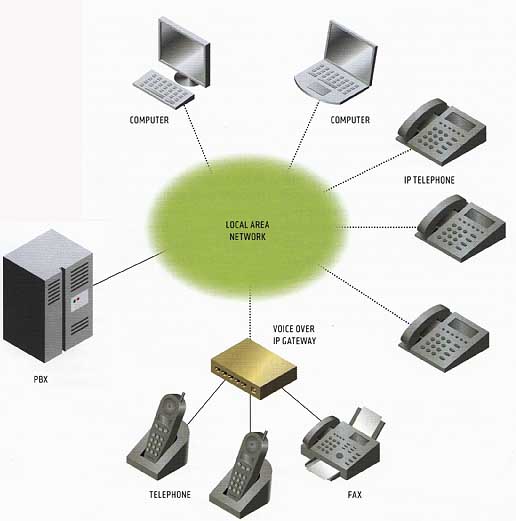
PBX -- The phrase “private branch exchange,” or “PBX,” was first applied when
switchboard operators ran company switchboards by hand. PBXs make connections
among the internal telephones of a private organization—usually a business—and
also connect them to the public switched telephone network (PSTN) via lines
from the telephone provider. Because they incorporate telephones, fax machines,
modems, and more, the general term “extension” is used to refer to any end
point on the branch. Dialing a number “to get an outside line” means using
a PBX.
===
Whether copper or fiber optic, cables for communication with the outside world to offices have often been connected to private branch exchanges (PBXs)—a system on the customer’s premises that manages all data and voice networks moving within a business. By handling intra-organizational calling privately, it reduces the charges for local phone service significantly. Today PBXs are increasingly taking the form of “hosted PBXs,” i.e., the various internal services are provided by the local telephone company at its own exchange under lease so that the customer does not need to provide all the switching equipment.
Telecom pathways
A variety of wires run through a skyscraper to ensure round-the- clock communication. Increasingly, landlords must provide convenient access to multiple telecom providers to meet tenant demands. To ensure reliable service, some office towers will be designed to feature not one but two points of connectivity with the outside world.
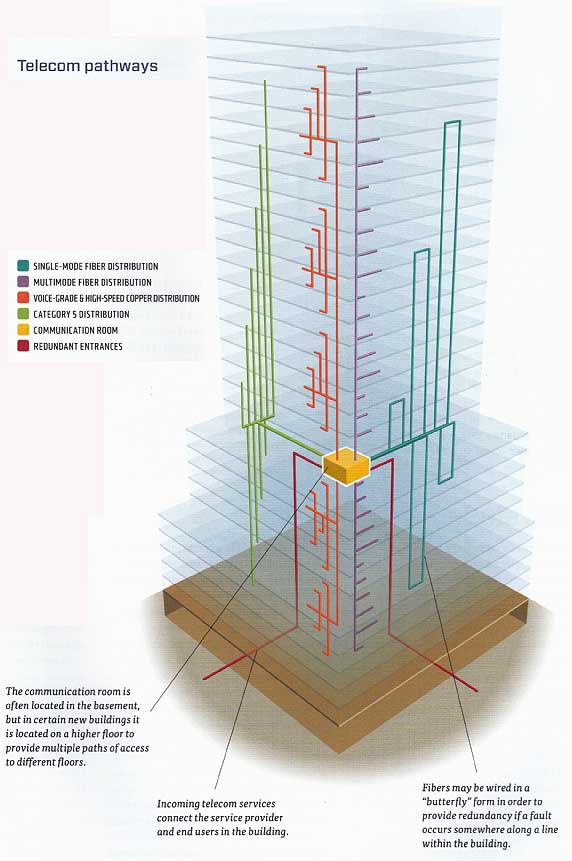
SINGLE-MODE FIBER DISTRIBUTION
MULTIMODE FIBER DISTRIBUTION
VOICE-GRADE & HIGH-SPEED COPPER DISTRIBUTION
CATEGORY-5 DISTRIBUTION
COMMUNICATION ROOM
REDUNDANT ENTRANCES
The communication room is often located in the basement, but in certain new buildings it’s located on a higher floor to provide multiple paths of access to different floors.
Incoming telecom services connect the service provider and end users in the building.
Fibers may be wired in a “butterfly” form in order to provide redundancy if a fault occurs somewhere along a line within the building.
===
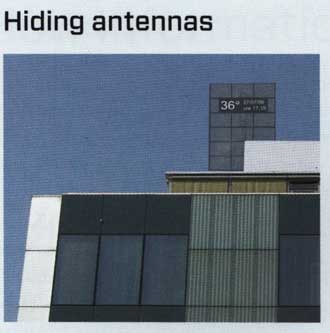
Hiding antennas:
Cell towers are harder to site in urban areas than they are in rural ones. Land for a stand-alone tower is rarely available, and zoning regulations often prohibit its construction. As a result, the roofs of tall buildings in cities are increasingly becoming home to cell transmission or booster equipment.
These fixtures, which generate a small revenue stream for building owners, take various forms. They may be in an outdoor cabinet, mounted on a side wall, or located just below the roof. Often an attempt will be made to blend into the building’s architecture or, even better, hide the fixture entirely from public view.
===
Over the last 20 years, wireless technologies have dramatically reshaped telecommunications. While these wireless systems have been much easier to implement in many places than cable-based connections, due to their lower capital and infrastructure requirements, they have proven somewhat more troublesome for tall-building owners as the cell signals find it hard, if not impossible, to penetrate the steel and concrete structures that support modern skyscrapers.
Cell coverage is a function of many things, including the strength and frequency of the signal, the size and power of the transmitter, the direction the signal is coming from, the intervening geography, and the weather. Even the largest cell towers have limited capacity, and the spacing of masts is generally a function of the density of the population they serve:
in urban locations cell towers must be as close as one quarter to one half mile apart, while in the suburbs they can be comfortably spaced a mile or more apart.
Like all radio signals following a predetermined path, cell signals deteriorate over distance. Even when they are picked up and redistributed by cables, fiber optics, and antennas, signals will lose strength as they move farther from their source. And while radio signals don’t necessarily need a clear line of sight to be effective, interposing obstacles serve to degrade or attenuate the strength of the cell signal, creating “dead zones” where service is inaccessible.
Dead zones within skyscrapers can be anywhere. In skyscrapers in urban settings, it’s the lower floors that can often suffer the poorest cell coverage due to interference from nearby buildings. But skyscraper structures themselves often interfere even with direct signals from outside towers. Steel beams, brick walls, and wallboard supports can block the strongest of signals— as firefighters at the World Trade Center on 9/11 sadly found out.
To overcome this problem, many modern skyscrapers feature systems of “boosters,” or “cellular repeaters,” that pick up cell signals coming from outside and repeat them inside the building (and vice versa). Repeaters generally include a base station, fiber optic radio heads that feed a fiber optic distribution system, and a special antenna. They can be located as densely as needed throughout a tall building—often on every floor. Most important, they must support the wireless systems of various carriers, each of whom uses different frequencies and technologies.
===
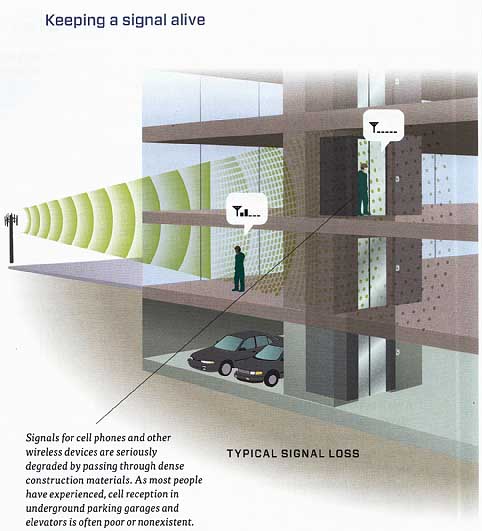
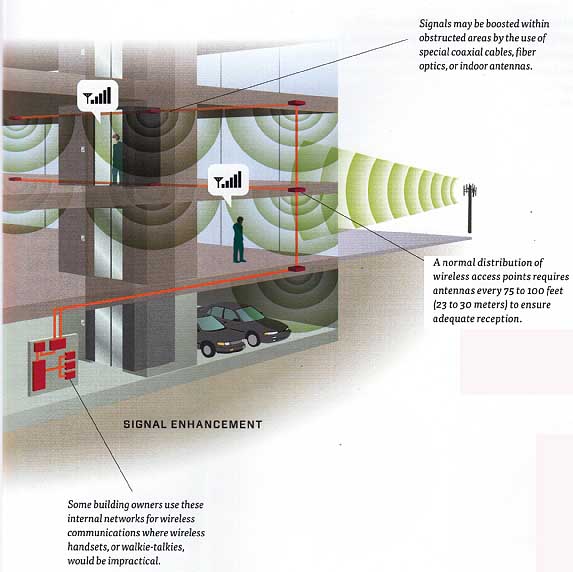
Keeping a signal alive:
Signals for cell phones and other wireless devices are seriously degraded by passing through dense construction materials. As most people have experienced, cell reception in underground parking garages and elevators is often poor or nonexistent. TYPICAL SIGNAL LOSS
A normal distribution of wireless access points requires antennas every 75 to 100 feet (23 to 30 meters) to ensure adequate reception.
Signals may be boosted within obstructed areas by the use of special coaxial cables, fiber optics, or indoor antennas.
SIGNAL ENHANCEMENT
===
Wireless:
Some building owners use these internal networks for wireless communications where wireless handsets, or walkie-talkies, would be impractical.
==
Beyond radio
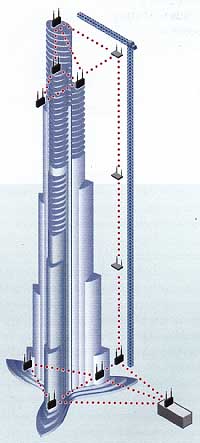
Most heavy construction relies on two-way radio communication among workers—or, as it’s known in the United States, “walkie talkie” communication. But as reliable as walkie-talkies have proven overtime, they are no match for the dizzying heights to which modern skyscrapers aspire.
During construction of the Bun Khalifa, walkie-talkies being used by Samsung employees stopped working once construction reached the thirtieth floor. To ensure continued communication between the crane operator and the men on the top floor, a new technology that converted radio signals from mobile devices to an IP signal using VoIP (voice over internet protocol) technology was introduced. It allowed communications to travel over a wireless mesh similar to those used in mobile phone systems, but more localized.
This mesh also offered the ability to transport video. As a result, in addition to restoring full communications among workers, the new system allowed construction managers on the ground to monitor in real time the safety of workers high up on the construction site.
===
Public Safety:
Telecommunications is not only important to residents and workers in tall buildings; it’s also critical to firefighters attempting to fight fires. Like workers on construction sites, firefighters within buildings have historically relied on their own form of walkie-talkies—both to communicate with one another on incident floors and with battalion chiefs organizing the deployment of personnel from remote locations.
But skyscraper walls and elevator shafts have proven as troublesome for firefighter radios as they have for cell phones. In some cases fire departments have found radio bands that successfully penetrate steel-and-concrete walls. In others they have devised special devices that merge a variety of radio or cell frequencies to allow multiple city agencies, including police and fire, to talk to one another. Some municipal fire departments have devised powerful mobile repeaters that can be carried by firefighters to strengthen the radio signals emanating from handheld devices on the fire floor.
==
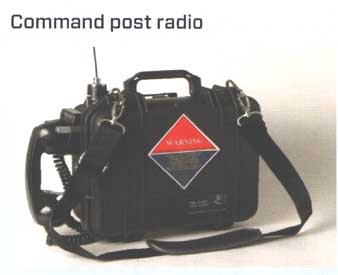
Command post radio -- One of the most effective weapons in fighting interference
from concrete and steel within a skyscraper is also one of the simplest. Shortly
after reports on the 2001 terrorist attack at the World Trade Center highlighted
poor communication among fire department personnel, one New York City fire
captain turned his energies to inventing a better mousetrap.
He took the battery from his daughter’s Jet Ski end hooked it up to an old marine radio, creating a high- powered mobile repeater that works effectively at the highest zone of the radio spectrum. A briefcase- sized device weighing 22 pounds (10 kilograms), his “command post radio” can be carried up to the fire floor to communicate effectively with fire personnel in other parts of the building. So strong is the signal emanating from the device that it comes with a nine-foot cord to allow firemen to stand away from the frequency radiation it emits.
==
Certain skyscrapers have more sophisticated systems for firefighters to use. Large buildings may have their own dedicated channel that provides a wireless spectrum in the event of a disaster. Others are dotted with repeaters, which can effectively bolster radio communication between firefighters. In both cases, however, these innovations are of little use if fire personnel don’t know how to use them: both buildings at the World Trade Center in New York had extensive repeater systems that were not used properly on 9/11.
_A portable repeater can be carried to the floor below the fire to facilitate communications between firefighters on high floors and chiefs in the building or outside.
Repeaters mounted on neighboring buildings or in mobile battalion communication cars can be used to boost signals.
Built-in repeaters boost handheld signals within the building.
LEAKY CABLE -- One of the most promising techniques to fight interference from structural obstacles in skyscrapers is something known as “leaky cable’—a technology successfully used in mines, underground shopping malls, and subway and utility tunnels. Slits are cut into a long cable that is threaded through the elevator shaft of a building and held in place by vinyl- coated steel clamps. The cable acts as a long antenna, receiving signals from hand held radios (walkie-talkies) through its slits and carrying them to the lobby or other remote location.
==
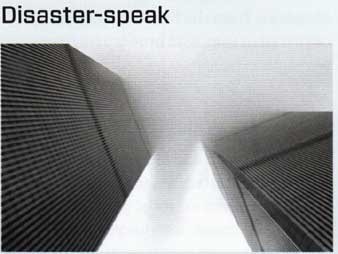
Disaster-speak:
There is not much that people have agreed on about 9/11, from the identity of its masterminds to the nature of its memorial. But one fact is generally accepted: poor radio communication among New York’s firefighters led to a greater loss of life at the World Trade Center than was necessary.
Two particular communication problems were largely to blame. The first was the degradation or obstruction of radio signals caused by the building’s structural steel beams. The second was the sheer volume of radio traffic, which overloaded the system and led to communication failures; at one point, 90 radios were attempting to share one frequency. Together these issues were responsible for somewhere between one-third and one half of all radio communication between fire personnel being unintelligible.
Cell phone service on 9/11 was also problematic as its volume spiked to levels well beyond what local carriers could handle. Yet, somewhat ironically, landlines in the World Trade Center continued to work for some time after the two planes hit the buildings. Police Department communications were also much more robust—possibly because their command center was set up more than a block away and had a direct line of sight with police personnel in the building.
==
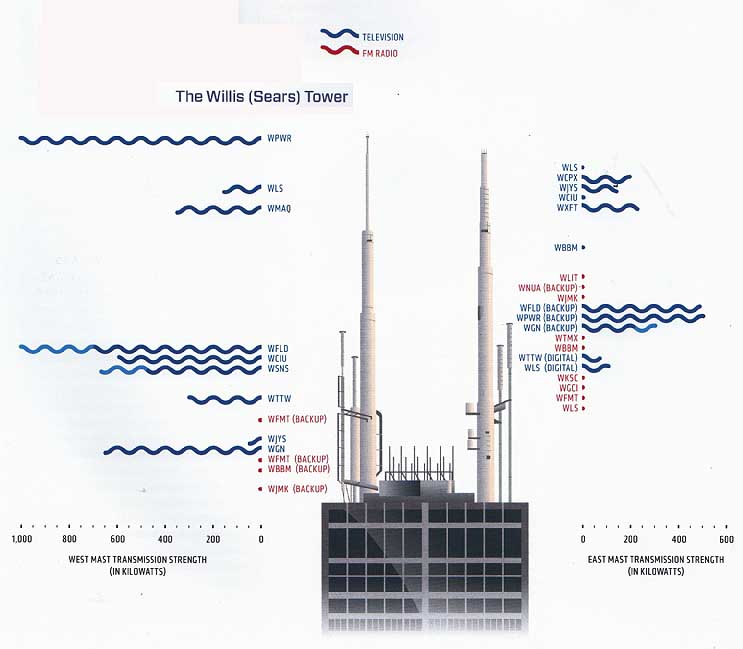
Broadcast Towers:
For almost 100 years, people have known that the crown of a skyscraper should be used for something—but it wasn’t always clear what. The spire on the Empire State Building, For example, was originally designed as a mooring mast for dirigibles. It was only when that idea proved unworkable that experimentation with radio and television transmission from its mast began.
The first commercial television station broadcast from the Empire State Building occurred in 1941, and broadcasts from other locations followed. In the early 1950s, thanks to federal intervention in what had been exclusively an NBC (National Broadcasting Company) arrangement, the Empire State Building mast became a consolidated location for competing radio and television channels. By the mid-196os a “master antenna” had been erected there and, until the opening of the World Trade Center in the early l it provided a base for nearly every television station (and many FM radio stations as well) in New York City.
Tall buildings serve as transmission centers for television and radio stations in many other cities as well. The antenna on the Willis (Sears) Tower in Chicago has broadcast signals for radio and television stations since the building opened in the early seventies. Today it serves as home to more than two dozen FM radio and several television stations.
Elsewhere, transmitting antennas can be found on a variety of tall buildings and structures, including the CN Tower in Toronto and the Eiffel Tower in Paris.
The Willis (Sears) Tower -- FM radio and television Stations broadcast from different locations atop the east and west masts of the Willis (Sears) Tower in Chicago, with varying amounts of transmission strength.
TELEVISION; FM RADIO
WPWR
WLS
WMAQ
WLS
WCPX
WITS
WCIU
WXFT W
WBBM’
WFLD
WCIU WSNS
WTTW
. WFMT (BACKUP)
WGN
. WFMT (BACKUP) i WBBM (BACKUP)
• WJMK (BACKUP)
WEST MAST TRANSMISSION STRENGTH (IN KILOWATTS)
WLIT
WNUA (BACKUP)’
WJMK
WELD (BACKUP)
WPWR (BACKUP)
WGN (BACKUP) we
WTMX
WBBM’
WTTW (DIGITAL)
WLS (DIGITAL)
WKSC
WGCI
WFMT
WLS
EAST MAST TRANSMISSION STRENGTH (IN KILOWATTS)
Switching Stations
Some skyscrapers devote more than just their crown to telecommunications—their entire form is designed specifically with telecommunications in mind. Known as “switching stations,” they exist around the world—often with very similar heights and appearances.
Switching stations exist to house the equipment used for long-distance telephony: they make the connections and relay the signals from one place or system to another. To protect the sensitive equipment inside, switching stations generally have windowless façades, often made of concrete. Ranging anywhere from 15 to 35 floors, they are built to be stronger than skyscrapers of comparable size—able to carry anywhere from four to six times the design load of a typical office floor and to remain standing in the event of a terrorist or other incident.
Because they contain massive amounts of sensitive equipment, switching stations require proper ventilation and feature one or more mechanical floors to ensure they get it. They also must contain backup generation that can seamlessly pick up the electrical load if for any reason power to the primary switching equipment fails.
NEW YORK CITY--The 29-story AT&T Long Lines Building in lower Manhattan is largely windowless for additional security and to protect expensive telecommunications equipment.
CLEVELAND -- The 11-story AT&T Annex in Cleveland is a windowless switching station.
CHICAGO--The AT&T building at 10 South Canal in Chicago is mostly windowless.
LOS ANGELES--The 17-story AT&T Switching Center has a distinctive microwave tower on the roof, which was used from 1961 to 1993. Today the building serves 1.3 million phone lines.
KANSAS CITY--The 20-floor AT&T Long Lines Building in Kansas City was constructed in five phases over nearly 25 years and completed in 1973.
Lightning:
Contrary to public opinion, lightning— the result of the buildup of a negative charge within an unstable, wet cloud—does not always strike the tallest structure around. But tall buildings are indeed more likely to experience lightning strikes than short ones, making skyscrapers—and the telecommunication and power equipment they contain—particularly vulnerable targets.
Along with broadcast masts, skyscrapers are hit more frequently than any other objects on earth. On average, a tall skyscraper will be hit between two and eight times during a given electrical storm. In Chicago and New York, with only a moderate level of storm activity, skyscrapers will experience between 50 and 110 strikes each year; in Florida, where electrical storms are much more frequent, a tall building would experience many more—up to 200 hits annually.
Although lightning can shatter windows and masonry, it’s not as much a danger to humans as it’s a threat to the communications systems they rely on. Direct lightning strikes can lead to the burnout of power and telecommunications equipment and to explosions of power distribution transformers. Strikes don’t have to be direct to cause damage: even distant lightning can create electrical surges that move through power, telephone, or plumbing lines to a building miles away.
To protect skyscrapers, lightning rods are placed at intervals of roughly 20 feet (six meters) around the perimeter of a flat building roof or along the peaks of a sloped roof. Generally made of copper or aluminum, these strips or rods will be connected to wires running from the roof to a grounding network under the building. These wires conduct and transfer the electrical charge from the sky to the earth.
In addition to lightning rods, buildings may also feature lightning “arrestors” for additional protection. Also called “surge protectors,” they are placed where wires enter a structure and provide a short circuit to the ground from the electrical conductors in a given communications or power system. By doing this they limit the rise in voltage when a particular power or telecom line is struck by lightning, thus preventing damage both to people and the electronic appliance itself.
With striking frequency...
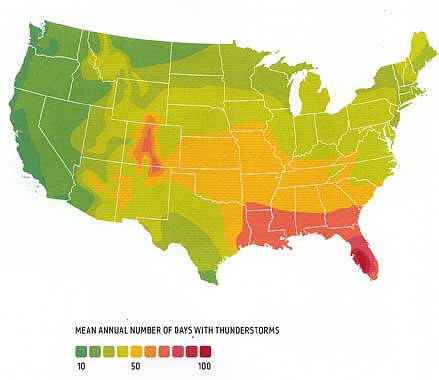
In the United States there are an estimated 25 million lightning flashes each year, with the largest number of them occurring in the southeast and the fewest in the western portion of the country. During the past 30 years, lightning killed an average of 58 people per year.
MEAN ANNUAL NUMBER OF DAYS WITH THUNDERSTORMS
10---50---100
Ground-to-cloud lightning:
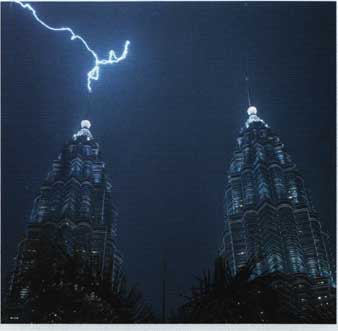
Lightning typically consists of a strong negative charge from a cloud reaching downward, rather explosively, to meet the positively charged ground below. One bolt of lightning will often branch off into multiple paths as it heads to earth, potentially hitting the ground in more than one place.
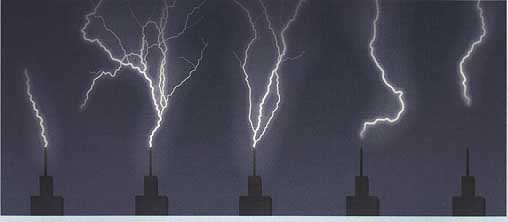
However, a different kind of lightning was identified in the decade after the Empire State Building opened in 1930. Called “ground-to cloud” lightning, it originates in the strike and conduct the energy to the ground.
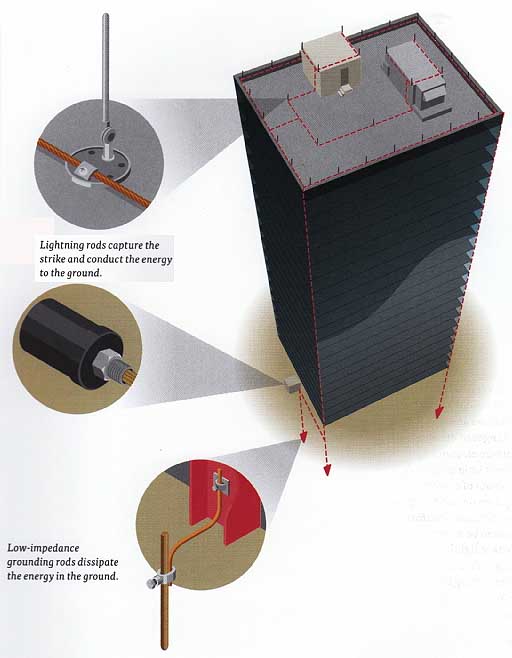
Lightning protection -- A lightning flash is composed of a series of strokes (generally about four). The length and duration of each varies, but typically averages about 30 millionths of a second, with peak power per stroke averaging just over 1,000 watts.
A surge arrestor is designed to limit overvoltages on equipment. A typical surge arrestor consists of disks of zinc oxide material encased in porcelain enclosures to provide physical support and remove heat.
Lightning rods capture the ground and reaches upward to the storm cloud above. It’s recognizable by its distinct tree-shaped form— with a trunk on the bottom and branches on top.
Ground-to-cloud lightning is not a rare occurrence: it’s responsible for the majority of skyscraper strikes. Upward discharges have been found to occur as frequently as every two to five minutes until the electrified portion of a storm region has passed, which can be up to an hour after the passage of the squall line itself.
Low-impedance grounding rods dissipate the energy in the ground.
Previous: Power, Air, and Water
Next: Life Safety
